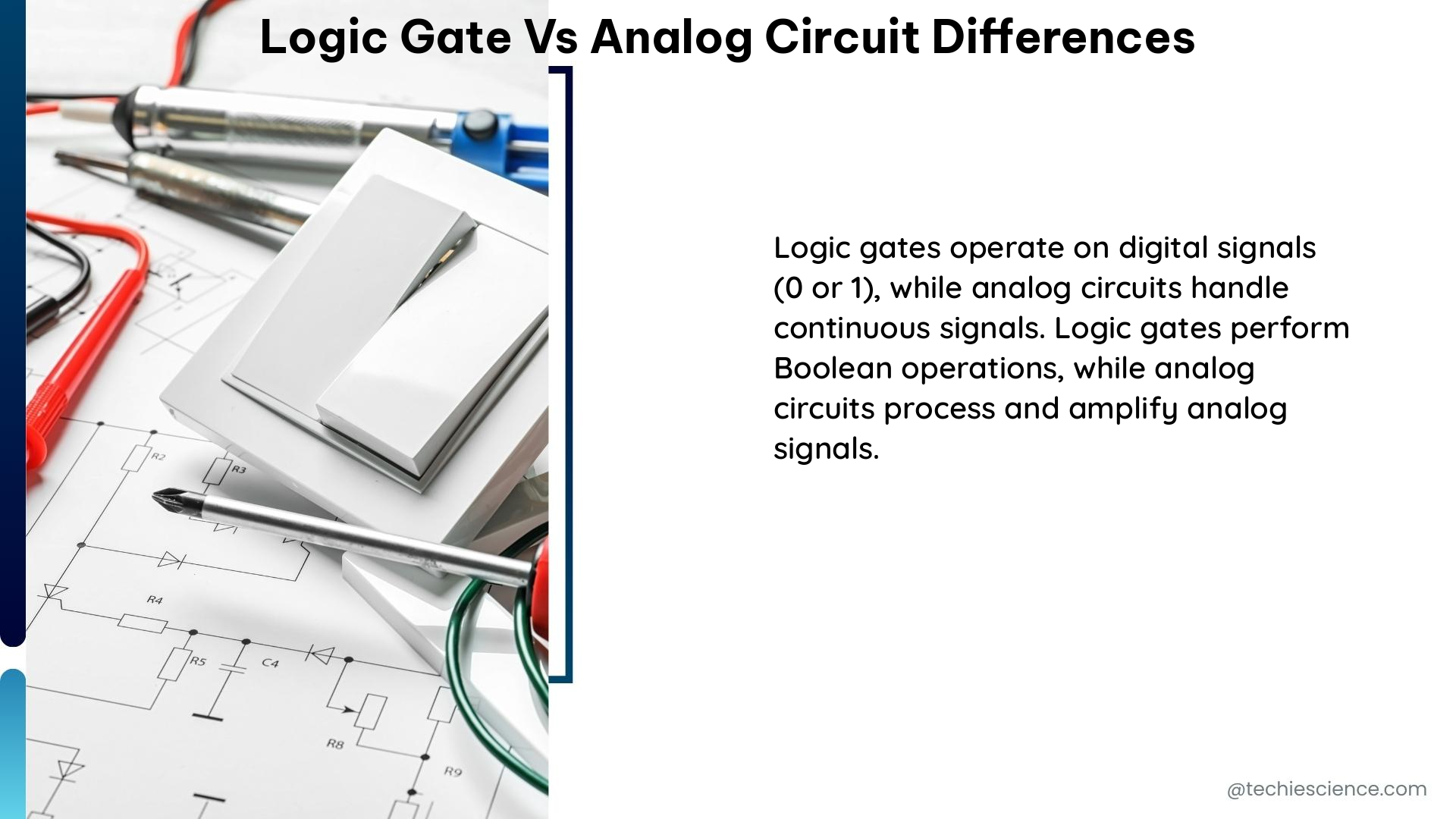Analog circuits and logic gates are two fundamental building blocks of electronic systems, each with its own unique characteristics and applications. Understanding the differences between these two types of circuits is crucial for designing and implementing effective electronic systems. In this comprehensive blog post, we will delve into the key differences between logic gates and analog circuits, providing a detailed and technical analysis to help you navigate the world of electronic design.
Signal Representation and Processing
The primary distinction between logic gates and analog circuits lies in the way they represent and process signals. Analog circuits use continuous signals that can take on any value within a given range, often represented by a voltage or current. These signals can vary smoothly and can represent a wide range of information, such as audio, video, or sensor data. In contrast, logic gates use discrete signals that can only take on two values, typically represented as high (1) and low (0). These binary signals are well-suited for performing logical operations, such as AND, OR, and NOT.
The continuous nature of analog signals allows for more accurate representation of information, but it also makes them more susceptible to noise and interference. On the other hand, the discrete nature of digital signals makes them more robust and less affected by noise, but they can lose some of the nuance and detail present in the original analog signal.
Accuracy and Precision

Analog circuits are generally more accurate in representing continuous signals, as they can capture the full range of values within a given range. This makes them well-suited for applications that require high-fidelity signal processing, such as audio and video systems. For example, a high-quality analog audio amplifier can faithfully reproduce the subtle nuances of a musical performance.
Logic gates, on the other hand, are more precise in performing logical operations. They can reliably distinguish between the two discrete states (high and low) and perform complex logical operations with a high degree of accuracy. This precision is crucial for digital systems, such as computers and microcontrollers, where the correct interpretation of binary data is essential for proper functioning.
Speed and Frequency Response
Analog circuits are generally faster in processing signals, especially at high frequencies, due to their continuous nature. This makes them well-suited for applications that require real-time signal processing, such as radio frequency (RF) circuits and high-speed communication systems.
Logic gates, on the other hand, have a finite switching speed, which can limit their performance at very high frequencies. However, digital circuits can often be designed to operate at much higher clock speeds than their analog counterparts, allowing for faster overall processing of digital data.
Noise Immunity and Power Consumption
Digital circuits, including logic gates, have higher noise immunity than analog circuits. This means they are less susceptible to interference from external sources, such as electromagnetic fields or power supply fluctuations. This makes digital circuits more reliable and robust in noisy environments.
In terms of power consumption, digital circuits, including logic gates, generally consume less power than analog circuits, especially for complex circuits with many components. This is because digital circuits can be designed to operate in a more efficient manner, with components switching between discrete states rather than continuously processing analog signals.
Complexity and Cost
Analog circuits can be more complex to design and implement than digital circuits, especially for high-frequency or high-precision applications. This is due to the need to carefully manage the behavior of continuous signals and the potential for interference and noise.
Logic gates, on the other hand, can be relatively simple to design and implement, especially for basic logical operations. This can make them more cost-effective, particularly for mass-produced digital systems.
Applications
Analog circuits are commonly used in applications that require continuous signal processing, such as:
– Audio processing (e.g., amplifiers, filters, mixers)
– Power electronics (e.g., power supplies, motor drives)
– Sensor interfaces (e.g., temperature, pressure, light sensors)
– Radio frequency (RF) circuits (e.g., transmitters, receivers)
Logic gates are commonly used in digital systems, such as:
– Computers and microcontrollers
– Memory devices (e.g., RAM, ROM)
– Digital communication systems (e.g., digital modems, digital signal processing)
– Digital control systems (e.g., industrial automation, robotics)
Conclusion
In summary, while both analog circuits and logic gates have their own strengths and weaknesses, they are optimized for different types of applications. Analog circuits are better suited for continuous signal processing and high-frequency applications, while logic gates are better suited for logical operations and digital systems. Understanding the key differences between these two circuit types is essential for designing and implementing effective electronic systems.
References
- Digital Circuits Explained | PDF | Logic Gate – Scribd: https://www.scribd.com/document/492875810/Digital-Circuits-E-Notes
- The differences between digital and analogue circuits: https://www.quarktwin.com/blogs/integrated%20circuit/the-differences-between-digital-and-analogue-circuits/181
- Digital and Analog Gene Circuits for Biotechnology – PMC – NCBI: https://www.ncbi.nlm.nih.gov/pmc/articles/PMC4077165/
- Overview of Digital and Analogue Electronic Design – DSL: https://www.dsl-ltd.co.uk/analogue-and-digital-electronic-design/
- Analog vs. Digital: https://learn.sparkfun.com/tutorials/analog-vs-digital/analog-and-digital-circuits

The lambdageeks.com Core SME Team is a group of experienced subject matter experts from diverse scientific and technical fields including Physics, Chemistry, Technology,Electronics & Electrical Engineering, Automotive, Mechanical Engineering. Our team collaborates to create high-quality, well-researched articles on a wide range of science and technology topics for the lambdageeks.com website.
All Our Senior SME are having more than 7 Years of experience in the respective fields . They are either Working Industry Professionals or assocaited With different Universities. Refer Our Authors Page to get to know About our Core SMEs.